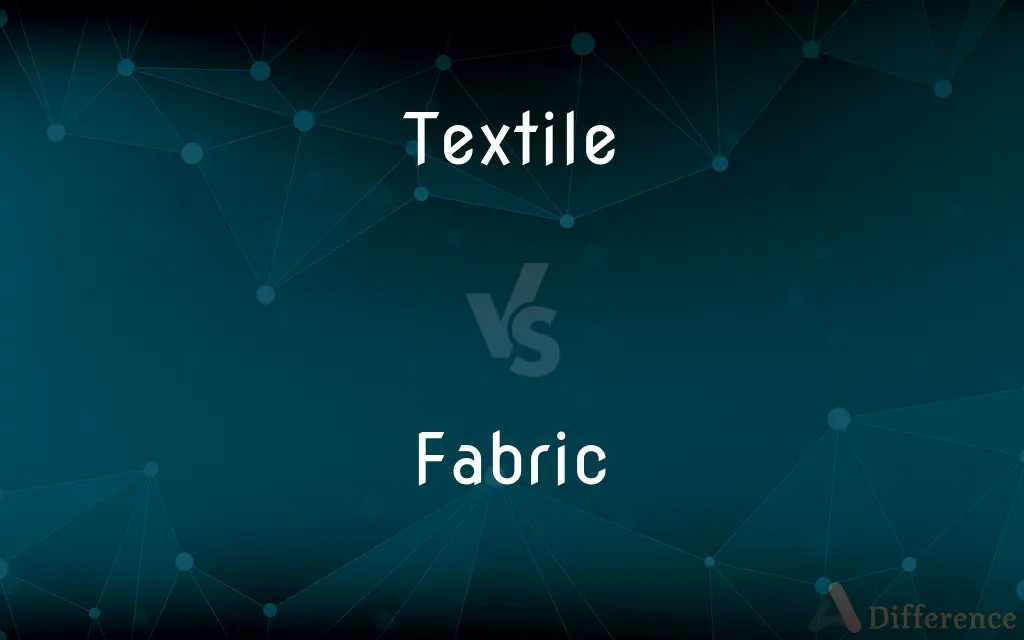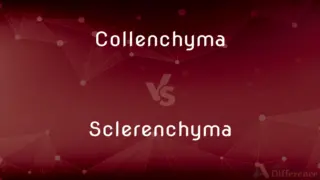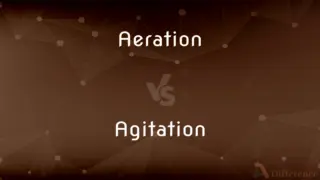Textile vs. Fabric — What's the Difference?
Edited by Tayyaba Rehman — By Urooj Arif — Updated on April 15, 2024
Textile refers to any material made from interlacing fibers, including fabric, whereas fabric specifically denotes textiles used for making clothes.

Difference Between Textile and Fabric
Table of Contents
ADVERTISEMENT
Key Differences
Textile is a broad category that encompasses all materials made from woven, knitted, or bonded yarns, while fabric is a subset of textiles specifically meant for clothing.
Textiles can be produced using various techniques like weaving, knitting, or non-woven processes, whereas fabric typically refers to materials produced by weaving or knitting.
The term 'textile' also applies to materials used in industrial and technical products, such as automotive, medical, and construction industries, on the other hand, 'fabric' is primarily associated with the fashion and home décor sectors.
Textiles have a wide range of applications beyond clothing, including furnishings, healthcare, and engineering, while fabrics are primarily designed for aesthetic and functional uses in apparel.
The production processes for textiles may involve complex chemical and mechanical steps to create materials with specific properties, whereas fabric production focuses more on color, texture, and pattern suitability for fashion and decor.
ADVERTISEMENT
Comparison Chart
Definition
Material made from interlacing fibers.
Textile specifically prepared for clothing.
Uses
Broad, including clothing, furnishings, industrial
Primarily for clothing and home décor.
Production Techniques
Weaving, knitting, bonding, felting, etc.
Mainly weaving and knitting.
Focus
Functional and technical performance.
Aesthetic appeal and comfort.
Industry Application
Automotive, healthcare, construction, etc.
Fashion, apparel, and interior design.
Compare with Definitions
Textile
Involves processes like spinning, weaving, and finishing.
The textile industry is a major economic player.
Fabric
Focuses on aesthetics and tactile qualities.
Velvet fabric is cherished for its soft texture and rich appearance.
Textile
Any product made from fibers or filament yarns.
Textile production has evolved significantly with technology.
Fabric
Material primarily used for sewing garments.
Silk fabric is preferred for luxurious garments.
Textile
Used in both functional and decorative applications.
Textiles are integral to both fashion and furnishings.
Fabric
Often treated for specific qualities like water resistance.
Many outdoor fabrics are waterproof.
Textile
Material created by weaving or knitting fibers.
Cotton is a popular textile used worldwide.
Fabric
Integral to fashion design.
Designers choose fabrics based on how they drape and feel.
Textile
Can be synthetic or natural.
Textiles like polyester are widely used due to their durability.
Fabric
Produced by intricate weaving of yarn.
Fabric patterns can vary from simple to complex weaves.
Textile
A textile is a flexible material made by creating an interlocking network of yarns or threads, which are produced by spinning raw fibres (from either natural or synthetic sources) into long and twisted lengths. Textiles are then formed by weaving, knitting, crocheting, knotting, tatting, felting, bonding, or braiding these yarns together.
Fabric
A cloth produced especially by knitting, weaving, or felting fibers.
Textile
A cloth, especially one manufactured by weaving or knitting; a fabric.
Fabric
The texture or quality of such cloth.
Textile
Fiber or yarn for weaving or knitting into cloth.
Fabric
A complex underlying structure
Destroyed the very fabric of the ancient abbey during wartime bombing.
Needs to protect the fabric of civilized society.
Textile
Any material made of interlacing fibres, including carpeting and geotextiles.
Fabric
A method or style of construction.
Textile
(naturism) A non-nudist.
Fabric
A structural material, such as masonry or timber.
Textile
(naturism) Clothing compulsive.
A textile beach
Fabric
A physical structure; a building.
Textile
Pertaining to weaving or to woven fabrics; as, textile arts; woven, capable of being woven; formed by weaving; as, textile fabrics.
Fabric
An edifice or building.
Textile
That which is, or may be, woven; a fabric made by weaving.
Fabric
(archaic) The act of constructing, construction, fabrication.
Textile
Artifact made by weaving or felting or knitting or crocheting natural or synthetic fibers;
The fabric in the curtains was light and semitraqnsparent
Woven cloth originated in Mesopotamia around 5000 BC
She measured off enough material for a dress
Fabric
(archaic) The structure of anything, the manner in which the parts of a thing are united; workmanship, texture, make.
Cloth of a beautiful fabric
Textile
Of or relating to fabrics or fabric making;
Textile research
Fabric
The physical material of a building.
This church dates back to the 11th century, though the great majority of its fabric is fifteenth century or later.
Fabric
The framework underlying a structure.
The fabric of our lives
The fabric of the universe
Fabric
A material made of fibers, a textile or cloth.
Cotton fabric
Fabric
The texture of a cloth.
Fabric
(petrology) The appearance of crystalline grains in a rock.
Fabric
(computing) Interconnected nodes that look like a textile fabric when diagrammed.
The Internet is a fabric of computers connected by routers.
Fabric
(transitive) To cover with fabric.
Fabric
The structure of anything; the manner in which the parts of a thing are united; workmanship; texture; make; as cloth of a beautiful fabric.
Fabric
That which is fabricated
Anon out of the earth a fabric hugeRose like an exhalation.
Fabric
Cloth of any kind that is woven or knit from fibers, whether vegetable, animal, or synthetic; manufactured cloth; as, silks or other fabrics; made of a fabric that is 50% cotton and 50% polyester.
Fabric
The act of constructing; construction.
Tithe was received by the bishop, . . . for the fabric of the churches for the poor.
Fabric
Any system or structure consisting of connected parts; as, the fabric of the universe.
The whole vast fabric of society.
Fabric
To frame; to build; to construct.
Fabric
Artifact made by weaving or felting or knitting or crocheting natural or synthetic fibers;
The fabric in the curtains was light and semitraqnsparent
Woven cloth originated in Mesopotamia around 5000 BC
She measured off enough material for a dress
Fabric
The underlying structure;
Restoring the framework of the bombed building
It is part of the fabric of society
Common Curiosities
How are textile and fabric different?
Textile is a general term for materials made from fibers, while fabric specifically refers to textiles designed for clothing.
Can the term textile and fabric be used interchangeably?
Yes, in many contexts, especially in fashion, the terms are used interchangeably, but they have distinct meanings.
How do textiles contribute to fashion?
Textiles provide the basic materials from which fabrics are made, shaping the fashion industry’s output.
What industries use textiles?
Textiles are used in various industries including fashion, automotive, healthcare, and construction.
Are all fabrics textiles?
Yes, all fabrics are considered textiles, but not all textiles are considered fabrics.
What role do fabrics play in interior design?
Fabrics are crucial in interior design, used for draperies, upholstery, and other decorative elements.
What are the specific uses of fabrics?
Fabrics are mainly used in apparel and home décor for aesthetic and functional purposes.
How do textile properties vary?
Textile properties vary based on fiber content, construction, and finishing processes.
What is the importance of fabric texture in fashion?
Fabric texture determines comfort, appearance, and suitability for specific styles or climates.
What is textile?
Textile refers to any material made by interlacing fibers, including natural and synthetic materials.
What is fabric?
Fabric is a type of textile specifically made for crafting garments and décor items.
What are the common production techniques for textiles?
Common techniques include weaving, knitting, and non-woven processes like felting.
Are textiles recyclable?
Many textiles are recyclable, depending on their material and chemical treatments.
Share Your Discovery

Previous Comparison
Collenchyma vs. Sclerenchyma
Next Comparison
Aeration vs. AgitationAuthor Spotlight
Written by
Urooj ArifUrooj is a skilled content writer at Ask Difference, known for her exceptional ability to simplify complex topics into engaging and informative content. With a passion for research and a flair for clear, concise writing, she consistently delivers articles that resonate with our diverse audience.
Edited by
Tayyaba RehmanTayyaba Rehman is a distinguished writer, currently serving as a primary contributor to askdifference.com. As a researcher in semantics and etymology, Tayyaba's passion for the complexity of languages and their distinctions has found a perfect home on the platform. Tayyaba delves into the intricacies of language, distinguishing between commonly confused words and phrases, thereby providing clarity for readers worldwide.
















































